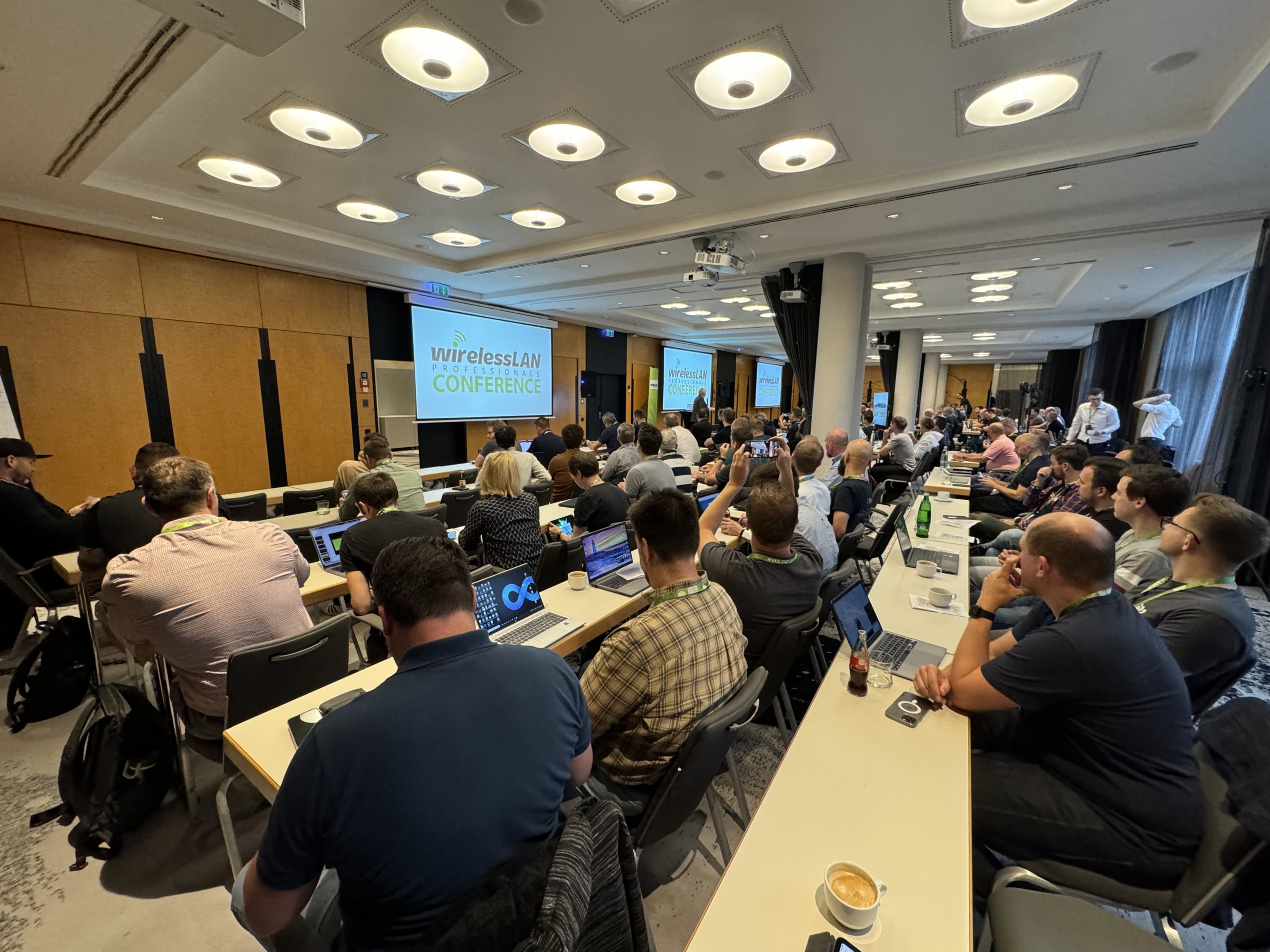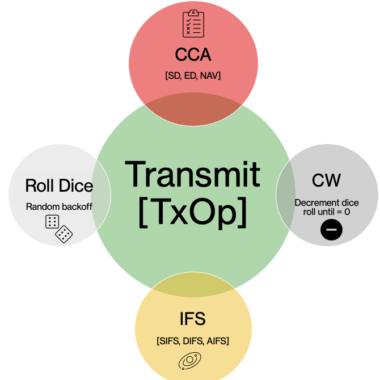WLPC EU 2023 Prague Conference Recap
Before the main WLPC conference officially starts, boot camps run for 3 days; they are a different animal. What would typically be a 4-day course is packed into 3 days of learning. It really is drinking from the firehose. The following boot camps ran in 2023 with an interesting note – there were two packet-capturing classes. This tells you a lot about the topics and skills WLAN practitioners are interested in.
- Rockstar Cisco 9800 by Chris Avants (@RockstarWifi)
- #LoRaWAN by Raymond Hendrix (@raymondhendrix) & Troy Martin (@troymart)
- Rockstar #Wireless Analysis by Rasika Nayanajith (@mrncciew)
- CWAP #WiFi Analysis by Peter Mackenzie (@MackenzieWiFi)
- CWNA-109 by Martin Erickson (@VoFi_Martin)

On the second night, most boot campers and many conference “early arrivals” journeyed to U krále Brabantského, the oldest beer house in Prague, for a medieval feast, surrounded by jugglers, sword fights, and dancers. I’m hoping this becomes a yearly tradition during the boot camps.


The Conference Itself
WLPC EU 2023 started with Keith Parsons (@KeithRParsons) welcoming a packed room and following his best practices for presenting by dropping a bunch of statistics. Selling an extra 15% of the seats at the last moment pushed the number of attendees above 160 with a large composition of 1st-time attendees. As such, Keith reminded everyone to be social and make a space to welcome new friends. 20% of attendees attended bootcamps, and 30% of attendees presented throughout the conference.

Sailing the seven seas of #WiFi7 was the title of the opening keynote delivered by the infamous David Coleman (@mistermultipath). During this talk, David described new layer 2 – upper MAC frame formats introduced to support multi-link optimization (MLO).
Nick Turner (@nickjvturner) and Jiri Brejcha (@jiribrejcha) gave the audience an update on the WLANPi project – the essential multitool for wireless pros. Cookbooks that describe steps to run various tasks, scripts, or utilities are now available at: go.wlanpi.com. In addition, shiny metal stickers are now included on the M4 & R4, allowing easy visual differentiation between the two models. Lastly, there is a new web UI with API in the works, with further details to follow at WLPC Phoenix 2024.
Jussi Kiviniemi (@JussiKiviniem) shared 10 things he has learned after having 1,000 wireless discussions with wireless people… apparently wired people do not have much to offer. The 10 things can be summarized as: Make tools fast, don’t let them get in the way, and ensure the report exporting is brilliant. However, this was a build-up to a new product announcement – the Nomad.
For the first 10-talk, Timo Sass (@dot11_de) demonstrated a future of efficient surveys by combining signal measurements for both Wi-Fi and 5G during the same survey walk. The Netztester 2 was a new tool announced to make this happen with a single device which integrates into an app collecting data and builds floor plans in 3D. The app is designed to be used by anybody, with no required training on how to walk. Contact Timo for more details on this app and perhaps an evaluation.
Stefan Kronawithleitner (@StefanKWL) detailed troubleshooting in Education…TLDR…get more data. Using several troubleshooting ticket scenarios with typical vague or bizarre descriptions, Stefan showed us how he collected more data to isolate and determine the root cause of each ticket.
Mark Houtz (@marko_with_a_k) spoke about the challenges of migrating to 6GHz with a mandatory requirement for WPA3, while preserving the mandatory single SSID name requirement for Eduroam. Global firmware support for transition mode becomes a challenge in this scenario, and some clients break when they see unsupported AKMs in transition mode frames. Having said this, client success is very good on 802.1X WLANs with PMF on 6GHz.
Matt Starling (@MattStarling) & Mac Deryng (@MacDeryng) demoed Ekahau’s new survey method – JustGo. This allows people to leverage the LiDAR Scanner in iOS devices to build a floor plan while surveying and matching the measured data to the location where it was collected. The second demo showcased packet capturing on any combination of up to 4 Wi-Fi channels simultaneously using the Sidekick 2.
Minse Kim (@Meraki_Minse) from Cisco/Meraki shared lessons learned from the client side of things. Making Keith Parsons happy, Minse dropped a lot of data around the number of devices capable of and using 11r. Slides suggested only 1.45% of WLANs had 11r enabled. However, this number included all WLANs, 802.1X, PSK, and open networks. A more meaningful statistic is that 10% of all 802.1X-based WLANs have 11r enabled (Cisco presents at #MFD10).
In an exciting first break, Drew Lentz (@WirelessNerd), popped up on stage to announce Cisco was giving ALL attendees a CW9166i with the internal directional antenna and a 5-year license to the Meraki dashboard. This is one of the most impressive vendor giveaways in WLPC history; as in proper Oprah form, ALL attendees received an AP – customers, partners, and even competitors. Cisco had the confidence and bravado to put their AP in everyone’s hands. Kudos to Cisco!
Jean Macq (@JeanMacq) delivered a breakdown of information elements (IE) and how Wi-Fi devices use them. Niels Boesten walked us through the best practices for deploying 6GHz from the CommScope (Ruckus) perspective. Ashley Mead (@Ashmeadwifi) described his WiFi design process for a football stadium WiFi.
Oguzhan Eren (@OguzhanEren802) spoke about warehouse WiFi, specifically designing warehouses without directional antennas. He challenged the status quo of promoting directionals by asking whether we should always use directional antennas in warehouse design. Added cost, design and installation complexity, and maintenance cost may be reasons not to use directional antennas. Oghuzhan defended his position with lots of real-world data to justify his conclusion that you can succeed in warehouses using down-tilt omnidirectional access points.
Martin Le Cossec explained how to monitor performance with Grafana and Prometheus. He showed how he viewed data from his network and shared a GitHub repository for attendees to build and play within their environment.
On the morning of the second day, Tauni Odia (@tauniodia) spoke about the Wi-Fi awards, reminding everyone to think about nominating someone, a product, or a company for an award in various categories. The community votes on the awards – there is no pay-to-play – it’s truly the people’s choice award for the Wi-Fi industry. Please take the time to nominate and vote. Award categories include:
- Product of the year
- Company leadership of the year
- People/Individuals content contribution of the year
Wes Purvis (@RealWesPurvis) delivered a fantastic presentation about the nuances of 6GHz deployments that implementers should know. There are too many options for 6GHz discovery, but clients are generally sticky to 6GHz, even when roaming. Wes recommends configuring your WLANs to deliver a quality experience for users and end devices, given the state of 6GHz today. This included how to tune SSID names, bandwidth, transmit power, and 802.11r + WPA3-SAE.
For the first time (and perhaps the last time), a panel discussion was led by Jennifer Minella (@jjx) with guests – Wes Purvis (@RealWesPurvis), Peter Mackenzie (@MackenzieWiFi), and Adrian Granados (@adriangranados). The four used a panel format to discuss challenges with WPA2 to WPA3 migrations and the trends being observed across the industry from different perspectives. If you liked this style of session, do let the WLPC organizers know. Otherwise, biases will likely prevent similar sessions from occurring in the future.
Sebastiano Bertani (@seba82go) presented an android-inspired approach to bring RF planning, QoE, and AI to the forefront. Have you used Tanaza? This almost made me want to start using my Pixel more often 😉
The story of the mythical radar and German angst was told by Rene Kriedemann (@wifiwise). If you want to know more about the impacts of radar, check out his presentation. Roméo Diaz explained why so many users complain that Wi-Fi doesn’t work in the warehouse and what Wi-Fi practitioners can do about it. Karsten Iwen (@KastenIwen) detailed the evolution of 802.1X and the refinement of this framework over the years.
Robert Boardman (@Robb_404) shared a dirty secret in the industry that many people try to deny. We are all in sales…selling Wi-Fi, APs, consulting, ideas, ourselves, or why we deserve a 3dB raise. Wherever we are, much of what we do as Wi-Fi Practitioners involves selling – or persuading others. Next, François Verges (@VergesFrancois) took the stage to explain the math behind 802.11be data rates and showcase updates to his website mcsindex.com.
Ferney Muñoz (@Ferney_Munoz) explained channel switch announcements (CSA) and their effect on WLANs. Sometimes, they are received, and other times, they are missed. Sometimes, announcements make a change, and other times, unexpected announcements occur. Using this as a segway, Ferney pivoted to making announcements about our friends in the WLAN community – there was an emotional conclusion to Ferney’s message.
After lunch, Jennifer Minella (@jjx) retook the stage to address a popular question at WLPC – when, why, and most importantly, how to upgrade to WPA3. Joel Crane (@Potato_Fi) described how the packet potato was designed and demoed feature updates available with the latest firmware flash. Find Joel in person to receive the update when you bring him your #PacketPotato and Li-Po charger.
Mika Hakala (@hakala_mika), from Sidos, walked the audience through several myths he sees in the WLAN design and survey space. Interesting points were raised, but they could equally be applied against the survey hardware and survey mobile app he demoed to address the myths he raised.
Adrian Granados (@adriangranados) provided an update on the state of the Intuitibits Wi-Fi Explorer and its recent port to Windows. This is a welcomed tool for the Windows side of the house. Although Mac users are vocal, there are significantly more Wi-Fi practitioners using Windows as their base OS who quickly install Wi-Fi Explorer.
Anders Nilsson (@HerrNilsson2) explained RADIUS, its brokenness, and the circle of Wi-Fi life. Diameter and Eduroam were also addressed. Troy Martin (that’s me!) (@troymart) spoke about the probability of collisions occurring given all the space between Wi-Fi frames at the time scale they operate. He suggested efficiency should be measured by reducing latency and the overall number of transmit opportunities.

The morning keynote of day 3 had Peter Mackenzie (@MackenzieWiFi) returning to the stage to ask attendees if offsets should be scrapped as a great clickbait title. Ultimately, he concluded with three rules: 1) No offset for design, 2) Design offset for validation, and 3) Device offset for assessment. While I don’t fully agree with Peter’s conclusion, it is a topic that requires a high level of understanding to be correctly applied. Many are using offsets without understanding the significance and what the offset is relative against.
Jim Palmer (@WirelessJimP) went into the details of standard power (SP) operation on the 6GHz band and sourced several documents he googled for the Samsung S23 Galaxy Ultra and Google Pixel 6aphones. Some clients are returning for recertification, resulting in dual-mode (6CD – dual-client-mode) operation – LPI (6XD) and SP.

Drew Lentz (@WirelessNerd) pondered if AI makes site surveys a thing of the past – hitting an emotional nerve and perhaps driving some people to start updating their resumes, or maybe it’s still too early?
It was wonderful to see the Wi-Fi Alliance represented by Consuelo Ortiz in attendance at WLPC. She provided an update on where the WFA focuses its energy and highlighted some recent milestones, such as certifying 80,000 devices.

David Coleman (@mistermultipath) encouraged us to write and produce content for ourselves and our careers before sharing news that an update to the CWNA-108 guide will not be released any time soon.
Dan Jones (@UKDanJones) emphasized the importance of reporting and communicating with customers to facilitate the efficient consumption of data when introducing the Client Education Tool (CET).
Clément Lemoine from Wave (by AGC) generated a lot of excitement with an alternative to antenna design in which elements are built into glass. Aesthetic glass antenna solution could see Wi-Fi antennas in exit signs and panels – items already legally required, which could also leverage direct RF energy. This has the potential to open many doors to keep the aesthetic committees in many WLAN design projects happy.
Ben Toner (@Ben_Toner) flaunted a new version of the nOversight application and shared a time-based discount code for new subscriptions. During the talk, he leveraged nOversight, to demonstrate how Wi-Fi deployments (such as a football stadium) could be validated and how to find the root cause of any reported client issues.
Amin Sedighaer, from Semfio, detailed considerations for outdoor Wi-Fi – specifically, best practices around design, installation, and maintenance of electrical grounding.
Deep Dives
Deep Dives, a fan favourite at WLPC took place on the afternoons of the first and second day. All attendees get to attend a Deep Dive, but many have capacity limits, and the popular ones fill up fast. Selecting the best deep dive for each attendee is a weighted decision based on metrics such as topic relevance, will this deep dive runs again, attendee swag, and the value of in-person instructor-led labs. Deep dive sessions included:
- Secure Wi-Fi Design – Jennifer Minella (@jjx)
- WLAN Pi – Jiri Brejcha (@jiribrejcha)
- Hamina Site Surveys and 3D Planning – Jussi Kiviniemi (@JussiKiviniem)
- Wi-Fi Explorer Pro – Windows & Mac – Adrian Granados (@adriangranados)
- AP Packet Capture – Peter Mackenzie (@MackenzieWiFi)
- Antenna Fundamentals – Jim Palmer (@WirelessJimP)
- Using a drone in your WLAN practice – Mike Wade (@WirelessKahuna)
As usual, vendor sessions took over in the evening, bringing people together for food and drinks and a chance to win free stuff in exchange for listening to marketing pitches.
On the last day of WLPC EU 2023, the call for topics for WLPC 2024 Phoenix was extended by one more day, allowing potential presenters to collect their thoughts and submit topics for the next conference in February.
My final thoughts on WLPC
Several sub-themes flowed through the conference, with numerous talks, deep dives, and boot camps covering those themes from different perspectives. As all topics were voted on, attendees and the community wanted to hear more about 6GHz in the field and how to prepare for SP with AFC. While this was great to see, it also generated a lot of repeat content around 6GHz channels and frequency allocation.
Several other talks addressed disruption for WLAN survey and design tools and workflows. Several new hardware and software products were announced in this space. A lot of work from the companies you know and love, as well as by some new entrants, is advancing the process of collecting data and tying that data to a location on a floor. There is a lot of room for improvement, and technology is starting to catch up to deliver on functions we’ve been waiting on for years. Leveraging AI and 3D-imaging, automated surveys are right around the corner.
WPA3 was also on the minds of many. More specifically, curiosity about the best practices for enabling or transitioning to WPA3. It boils down to asking lots of detailed questions. Some would say, “It depends!”, but that is just a way of saying, “I don’t know the right questions to ask,” or “I am too lazy to ask the right questions,” to provide clarity to what configuration supports specific business needs. At present, not all Wi-Fi devices support WPA3, and some do not support transition mode (WPA2/WPA3). Just because some devices are not supported, if they will never connect or are not intended to be supported on your WLAN, you are not obligated to configure your WLAN to support them.
Lastly, there was a noticeable decrease in stickers floating around, but some were to be found.
Slàinte!
Resources
FCC ID GX7AS: Google Pixel 6a
https://fcc.report/FCC-ID/A4RGX7AS
FCC ID SMS918B: Samsung S23 Ultra